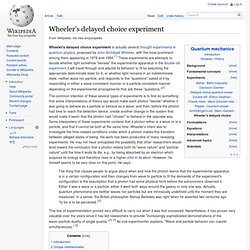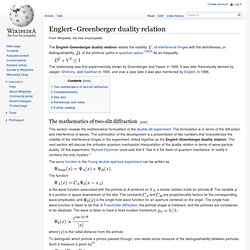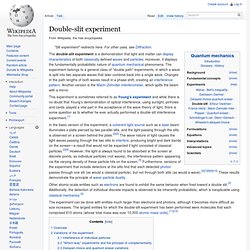

The Feynman Double Slit. Here we discuss one of the two major paradoxes that we use to introduce Quantum Mechanics.

It is the double slit experiment for bullets, water waves and electrons. Although many people have experimented with the systems to be discussed and written about them, Richard Feynman's treatment is so clear that physicists often call it the "Feynman" double slit. At the end, 2 references are given so you may read the "master" on this topic. With one exception noted below, each section of this "page" depends on the previous sections. Nonetheless, for review purposes you may jump directly to any section by clicking on it in the following Table of Contents: If you are reading this document on-line, there are a couple of links to Flash animations. Operational Definitions for "Particles" and "Waves" An "operational definition" is just a well-defined repeatable experimental procedure whose result defines a word or words.
I administer the Stanford-Binet IQ test to a person and score the result. Www.raulbarrachina.com.ar/research/preprints/2007jop88p012020.pdf. Wheeler's delayed choice experiment. Wheeler's delayed choice experiment is actually several thought experiments in quantum physics, proposed by John Archibald Wheeler, with the most prominent among them appearing in 1978 and 1984.[1] These experiments are attempts to decide whether light somehow "senses" the experimental apparatus in the double-slit experiment it will travel through and adjusts its behavior to fit by assuming the appropriate determinate state for it, or whether light remains in an indeterminate state, neither wave nor particle, and responds to the "questions" asked of it by responding in either a wave-consistent manner or a particle-consistent manner depending on the experimental arrangements that ask these "questions.

"[2] This line of experimentation proved very difficult to carry out when it was first conceived. Nevertheless, it has proven very valuable over the years since it has led researchers to provide "increasingly sophisticated demonstrations of the wave–particle duality of single quanta. The H2 Double-Slit Experiment: Where Quantum and Classical Physics Meet. For the first time, an international research team carried out a double-slit experiment in H2, the smallest and simplest molecule.
Thomas Young's original experiment in 1803 passed light through two slits cut in a solid thin plate. In the groundbreaking experiment performed at ALS Beamlines 4.0 and 11.0.1, the researchers used electrons instead of light and the nuclei of the hydrogen molecule as the slits. The experiment revealed that only one "observing" electron suffices to induce the emergence of classical properties such as loss of coherence. Double photoionization of H2.
Left: Circularly polarized light comes from the top. Present-day single photoionization experiments demonstrate double-slit self-interference for a single particle fully isolated from the classical environment. Englert–Greenberger duality relation. The Englert–Greenberger duality relation relates the visibility, , of interference fringes with the definiteness, or distinguishability, , of the photons' paths in quantum optics.[1][2][3] As an inequality: The relationship was first experimentally shown by Greenberger and Yassin in 1988.

It was later theoretically derived by Jaeger, Shimony, and Vaidman in 1995, and over a year later it was also mentioned by Englert, in 1996. The mathematics of two-slit diffraction[edit] This section reviews the mathematical formulation of the double-slit experiment. The wave function in the Young double-aperture experiment can be written as The function is the wave function associated with the pinhole at A centered on ; a similar relation holds for pinhole B. Is a position in space downstream of the slits. And are proportionality factors for the corresponding wave amplitudes, and. Double-slit experiment. The double-slit experiment is a demonstration that light and matter can display characteristics of both classically defined waves and particles; moreover, it displays the fundamentally probabilistic nature of quantum mechanical phenomena.

The experiment belongs to a general class of "double path" experiments, in which a wave is split into two separate waves that later combine back into a single wave. Changes in the path lengths of both waves result in a phase shift, creating an interference pattern. Another version is the Mach–Zehnder interferometer, which splits the beam with a mirror.